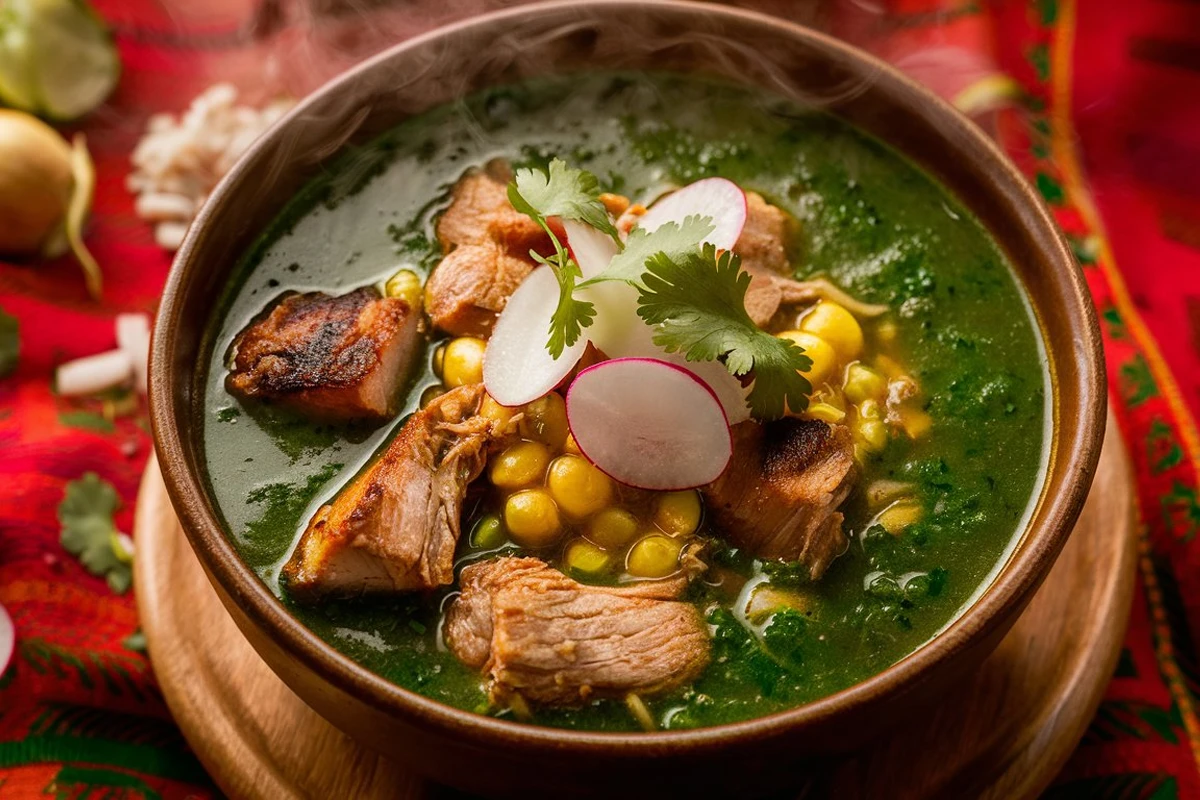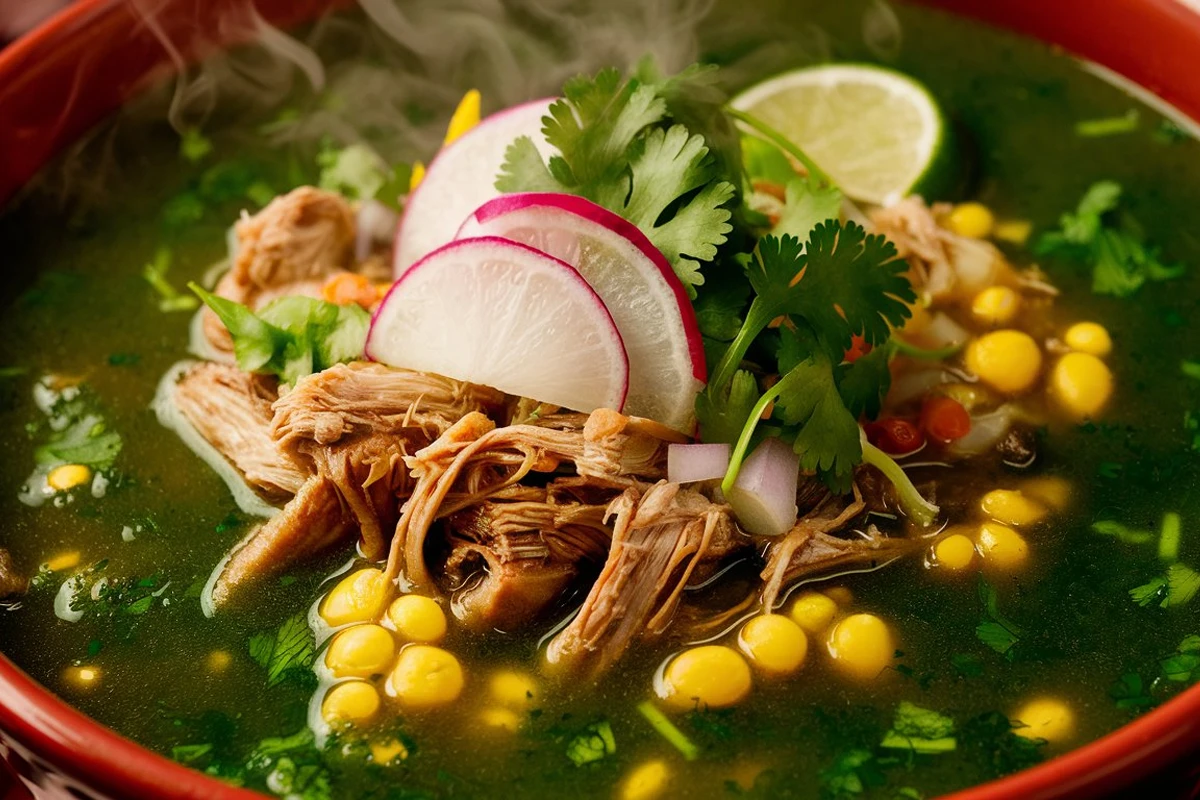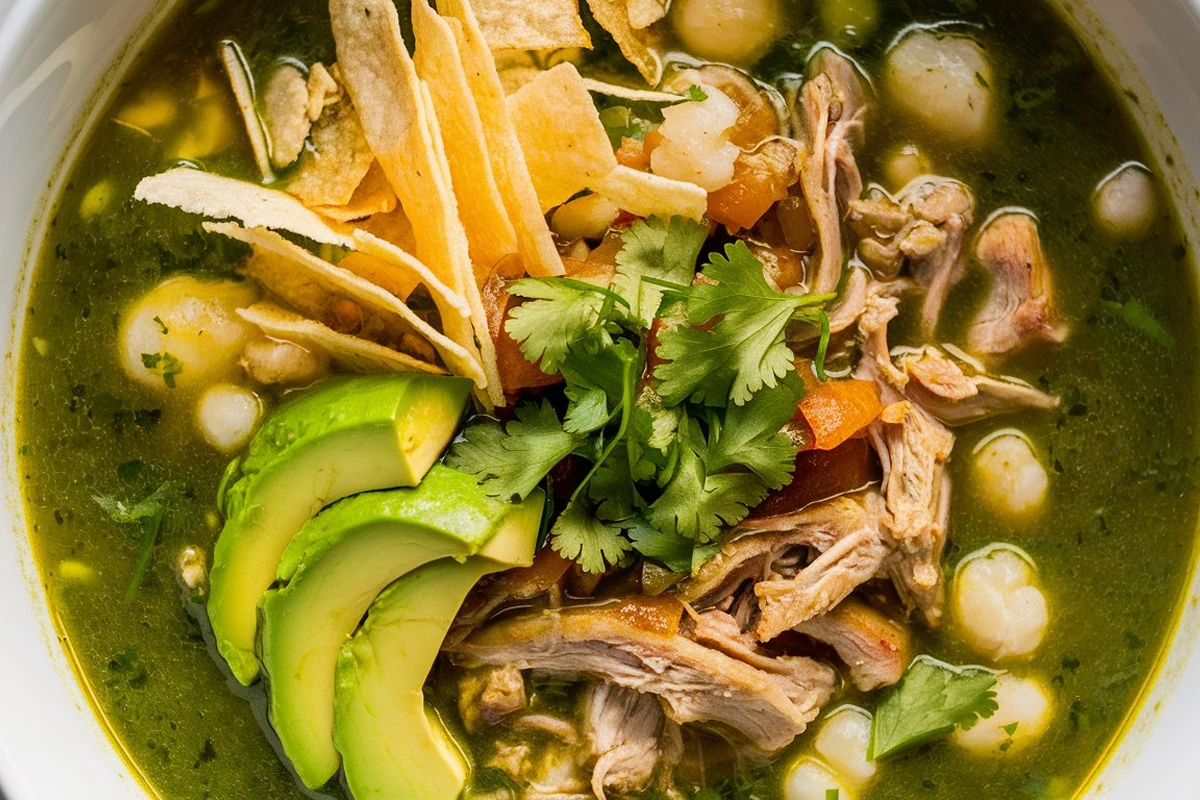Introduction to Pozole Verde de Puerco
Pozole Verde de Puerco, a cherished stew in Mexican cuisine, embodies the harmony of robust flavors and deep-rooted traditions. This dish isn’t just a meal; it’s a celebration of culture, brimming with the zest of tomatillos, the heartiness of pork, and the rustic texture of hominy. As we delve into the essentials of preparing this beloved stew, we’ll explore its ingredients, cooking techniques, and the various ways it’s savored across Mexico. Prepare to infuse your kitchen with the spirit of Mexican culinary artistry.
Introduction to Pozole Verde de Puerco
Understanding the Dish
Pozole, a traditional Mexican soup, comes in many variations, but Pozole Verde de Puerco is particularly renowned for its vibrant, green hue and hearty consistency. Originally deemed sacred by ancient cultures, today’s pozole is a festive fixture, often gracing tables during celebrations like New Year’s and birthdays.
Historical Significance and Cultural Context
The story of Pozole dates back to pre-Columbian times when it was part of ritual sacrifices. Thankfully, modern adaptations focus solely on culinary delight, minus the ancient rites! This dish has evolved, but its essence—a communal stew, simmering with history and shared with loved ones—remains unchanged.
Varieties of Pozole
While exploring Pozole Verde de Puerco, it’s fascinating to note the other siblings in the pozole family: the red pozole, seasoned with a blend of chilies, and the white pozole, which is simpler but equally satisfying. Each type has its own set of fans, but the green version, made with a rich salsa of pumpkin seeds, green chilies, and tomatillos, offers a refreshing twist on the traditional.
Ingredients and Preparation
Ingredients List
To embark on your culinary journey with Pozole Verde de Puerco, you’ll need a blend of vibrant and fresh ingredients. Essential to the dish are:
- 1.5 pounds of pork shoulder, cut into chunks – the star protein that offers richness.
- Hominy – canned or dried, this treated maize adds a delightful chew and is pivotal to the stew’s base.
- Tomatillos – these green, husked fruits impart a tangy acidity that’s crucial for the verde sauce.
- Poblano peppers and jalapeños – for that kick of heat and depth of flavor.
- Pumpkin seeds – ground to thicken the sauce and add a subtle nuttiness.
- Garlic, onions, and a generous bunch of cilantro – for the aromatic backbone.
- Limes and radishes for garnishing – adding a crisp, fresh contrast to each serving.
Preparation Steps
Now, let’s roll up our sleeves and start the cooking process, which promises to be as rewarding as it is aromatic.
- Broth Creation: Begin by simmering the pork in a large pot filled with water and a pinch of salt. This process, lasting about two hours, extracts the rich flavors from the pork, forming a hearty broth as the foundation of your pozole.
- Roasting Vegetables: While the pork cooks, roast tomatillos, poblano peppers, and jalapeños until charred. This step is crucial for developing the smoky flavor typical of a genuine Pozole Verde.
- Blending the Sauce: Blend the roasted vegetables with pumpkin seeds and a handful of cilantro until smooth. This green sauce will be what gives the pozole its signature color and vibrant flavor.
- Combining Elements: Once the pork is tender, add the strained hominy and the green sauce to the broth, simmering everything together to allow the flavors to meld beautifully.
- Final Touches: Season with salt and pepper to taste, and simmer for an additional 30 minutes to let all elements come together into a harmonious blend.
After these steps, your Pozole Verde de Puerco will be ready to serve, promising a bowl filled with flavors that are as rich in taste as they are in cultural heritage. Garnish with sliced radishes, chopped cilantro, and a squeeze of lime to enhance the freshness and balance the hearty flavors of the stew.
Regional Variations
Variations Across Mexico
Pozole Verde de Puerco is a dish that beautifully illustrates the diversity of Mexican culinary traditions, changing subtly or significantly from one region to another. In the southern state of Guerrero, for instance, pozole verde tends to be spicier and includes a unique blend of local herbs. Contrastingly, in the central regions like Jalisco, the dish might be milder but richer in hominy, reflecting the agricultural patterns of the area.
Impact of Regional Ingredients and Techniques
The local availability of ingredients plays a crucial role in these variations. Coastal regions might add seafood to their pozole verde, while inland areas might use different types of meat, such as chicken or beef, depending on local preferences and livestock availability. Similarly, the technique of preparing the salsa—whether charred, raw, or boiled—can also vary, each method imparting a different depth and complexity to the dish.
This diversity not only enriches the dish but also tells a story of the geographical and cultural landscapes of Mexico, making pozole verde not just a meal but a narrative of its people and their land.
Nutritional Information
Health Benefits
Pozole Verde de Puerco is not only delicious but also offers various nutritional benefits. Hominy, the processed corn in pozole, is a good source of fiber and magnesium. The pork provides high-quality protein, essential for muscle repair and growth. Moreover, the abundance of tomatillos and peppers contributes vitamin C and other antioxidants that support immune health.
Dietary Considerations
For those mindful of dietary needs, pozole can be adapted to meet different health considerations. For instance, using lean cuts of pork or chicken can reduce the fat content, making it suitable for heart-healthy diets. Additionally, for those avoiding gluten, pozole is naturally gluten-free, relying on corn rather than wheat or other gluten-containing grains.
Serving and Pairing Suggestions
Serving Suggestions
When it comes to serving Pozole Verde de Puerco, presentation plays a key role. Traditionally, serve this vibrant stew in large bowls to highlight its rich colors and textures. Sprinkle chopped cilantro and diced onions on top to enhance its visual appeal and flavor. Adding a wedge of lime on the side lets guests customize the tanginess to their liking.
For a truly authentic experience, accompany the pozole with warm, soft tortillas or a stack of crispy tostadas. These add a delightful crunch and are perfect for scooping up the flavorful broth. Also, a side of arroz rojo (red rice) complements the green hues of the pozole and rounds out the meal.
Pairing Drinks
Selecting the right beverage to accompany Pozole Verde de Puerco can elevate the meal. Opt for a chilled glass of agua de jamaica; its tartness beautifully balances the stew’s rich flavors. Alternatively, a sweet and fruity agua fresca de mango refreshes the palate, especially after a spicy bite.
Sparkling water with a squeeze of fresh lime juice also makes an excellent choice, offering a crisp and refreshing contrast to the hearty pozole. These drink pairings not only cleanse the palate but also prepare it for the next flavorful spoonful.
Modern Twists on the Traditional Recipe
Contemporary Variations
Chefs and home cooks alike have begun exploring contemporary variations of Pozole Verde de Puerco, infusing new life into this traditional dish. Modern versions may feature turkey or vegetarian options like jackfruit, providing pork-like texture in a plant-based alternative.
Another innovative twist involves the incorporation of different greens like spinach or kale, blending these into the salsa for an extra dose of nutrients and a different flavor profile. Some cooks enhance pozole with coconut milk, adding a sweet creaminess that complements tomatillos and spicy peppers for extra flavor.
Modern variations of this classic dish appeal to diverse tastes, sparking kitchen creativity and honoring Pozole Verde de Puerco’s culinary legacy.
User Experience and Testimonials
Customer Reviews and Testimonials
The impact of Pozole Verde de Puerco on family gatherings and festive occasions is profound. Numerous testimonials from those who have embraced this dish highlight its ability to bring people together, offering comfort and joy through its wholesome, flavorful broth. “Every time I make pozole verde, it feels like a celebration,” shares one home cook. “It’s not just about eating; it’s about sharing love and tradition.”
Stories and Quotes
Many families regard Pozole Verde de Puerco as more than just food; it is a cherished tradition, often passed down through generations. “This recipe was my grandmother’s,” mentions another enthusiast, “and making it keeps her memory alive in our family feasts.” These personal stories underscore the dish’s cultural significance and emotional resonance, making every pot of pozole a repository of memories and communal ties.
Tips for Perfecting Pozole Verde
Crafting the perfect Pozole Verde de Puerco involves more than following a recipe; it’s about mastering techniques and embracing flexibility. First off, always sear the pork pieces to lock in flavor. This step creates a rich base that elevates the broth. Additionally, soak dried hominy overnight if you’re not using canned; this ensures it cooks evenly and absorbs flavors fully.
When preparing the verde sauce, balance is key. Hence, taste as you blend, adjusting the heat with more or less jalapeño. Moreover, don’t rush the simmering process. Letting the stew simmer gently allows the flavors to meld beautifully, enhancing the overall depth. For those who enjoy a thicker broth, consider blending some of the hominy into the sauce. This technique thickens the stew naturally, without detracting from its traditional texture.
Remember, the garnishes you choose can transform the dish. Therefore, offer a variety of toppings like diced avocados, chopped onions, and fresh lime wedges. Each addition lets guests customize their bowl, tailoring the flavor to their preference. Furthermore, keep a watchful eye on the seasoning. Adjust salt and pepper towards the end of cooking to ensure the right balance, as the flavors develop and concentrate over time.
Lastly, always serve Pozole Verde de Puerco hot. A steaming bowl not only warms the body but also enhances the aromatic experience, making each spoonful a delightful exploration of taste.
Enhancing Flavor Through Condiments
Adding condiments to Pozole Verde de Puerco not only enhances its flavor but also elevates its texture and complexity. Firstly, consider incorporating a splash of freshly squeezed lime juice directly into the pot. This not only brightens the flavors but also adds a refreshing zest. Furthermore, a sprinkle of finely chopped cilantro contributes a burst of freshness, complementing the rich stew perfectly.
Adding a dollop of sour cream or a sprinkle of crumbled queso fresco can bring a creamy balance to pozole’s spiciness. Moreover, for an extra kick, a drizzle of hot sauce or a pinch of crushed red pepper flakes can turn up the heat for those who prefer their stew with a fiery touch.
Also, pickled vegetables, such as jalapeños or carrots, can add a tangy contrast that cuts through the richness of the stew. Likewise, offering a side of crispy tortilla strips provides a satisfying crunch that pairs wonderfully with the hearty, soft textures within the bowl.
FAQs about Pozole
What was in the original pozole?
The original pozole featured maize and was often enriched with meat, typically from game animals or, during ceremonial feasts, sacrifices.
Where did green pozole originate?
Green pozole, or Pozole Verde, originated in the southern regions of Mexico, where local green ingredients like tomatillos and jalapeños are plentiful.
What is Mexican pozole?
Mexican pozole is a traditional soup or stew, famed for its base of hominy and meat, usually pork, seasoned with a variety of chilies and other spices.
How did the Aztecs make pozole?
The Aztecs simmered hominy with meats to make pozole, a stew with cultural and spiritual significance often included in ritual offerings.
Conclusion: Celebrating the Legacy of Pozole Verde de Puerco
In conclusion, Pozole Verde de Puerco stands not only as a culinary delight but also as a cultural emblem. This dish bridges past and present, offering a taste that resonates deeply within the Mexican heritage. Each spoonful of pozole is a tribute to the rich history and the diverse flavors of Mexico.
Pozole’s versatility accommodates diverse regional tastes and dietary preferences, uniting communities with a shared love for this adaptable dish. Whether craving Jalisco’s spicy kick or Guerrero’s herb-infused milder version, pozole verde satisfies diverse preferences, catering to all tastes.
Making and sharing pozole strengthens family bonds and builds community, transforming meals into joyous celebrations of togetherness. It’s more than just food; it’s a communal experience that brings people together.
As we innovate traditional recipes, Pozole Verde de Puerco showcases Mexican culinary traditions’ creativity and resilience. It encourages chefs and home cooks to preserve flavors, ensuring this beloved dish continues to inspire future generations.
Whether a seasoned chef or a curious foodie, making Pozole Verde de Puerco connects you to centuries of tradition. So, gather your ingredients, share your table, and celebrate the enduring legacy of this magnificent stew.



